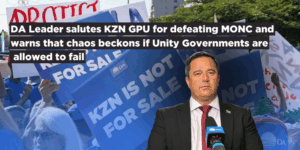- The decrease in load-shedding stages in South Africa appears to be a pause in maintenance to temporarily increase power generation.
- Eskom continues to underperform, with its Energy Availability Factor remaining below 60%.
- It is crucial for Ramokgopa, Mantashe and Gordhan to be honest and transparent about the current state of affairs.
Please find attached a soundbite by Kevin Mileham MP.
The recent decline in load-shedding stages has sparked residents and businesses to ask: Is the government finally gaining control over rolling blackouts? Unfortunately, the answer is no.
There’s a growing suspicion that Eskom halted maintenance for a temporary boost in generation. But is it a short-term fix or part of a long-term plan? South Africans deserve answers.
Despite assurances, Eskom’s Energy Availability Factor – the percentage of electricity generated compared to its installed capacity -remains below 60%. Their underperforming coal fleet and lack of transparency foster distrust.
Reduced demand and improved private generation have narrowed the gap between supply and demand, but it’s unsustainable and any sudden changes could lead to a swift return to stage 6 or higher load-shedding. We need transparency from Eskom, the Department of Energy, and the Department of Public Enterprises.
It is, therefore, imperative that Eskom, the Department of Energy, the Department of Public Enterprises, and the National Electricity Crisis Committee (NECOM) adopt a transparent approach in South Africa. We need to be regularly informed about the following:
- The extent of (i) planned and (ii) unplanned outages at Eskom;
- The capacity and fuel costs associated with peaking plants; and
- The amount of electricity procured from neighbouring countries, including the source of this electricity and whether it is in addition to previous procurements.
Furthermore, it is evident that the government must promptly update the Integrated Resource Plan, which serves as South Africa’s electricity roadmap. This plan guides the government’s decisions on when, where, and how to invest in electricity generation and transmission.
The current version, last updated in 2019, quickly became outdated due to inaccurate assumptions, particularly regarding Eskom’s Energy Availability Factor. Minister Gwede Mantashe, responsible for this task, should be held accountable for the overdue update.
It is increasingly apparent that South Africa cannot rely solely on the government to resolve the electricity crisis. Moreover, the inconsistent and unreliable information being presented is concerning.
Therefore, the DA will continue to advocate for an accelerated Integrated Resource Plan that addresses our electricity needs, facilitates the entry of independent power producers into the grid, and promotes self-generation projects to alleviate demand. Urgent attention should be given to upgrading the grid infrastructure to enhance access for independent power producers and ensure improved stability and load balancing.
Consequently, the DA calls upon the three ministers—Ramokgopa, Mantashe, and Gordhan—to appear before an urgent joint parliamentary committee and provide the people of South Africa with explanations about the ongoing efforts, responsible parties, and expected outcomes beyond short-term load-shedding mitigation measures.
We cannot allow a self-inflicted crisis to grant the government unrestricted power to procure, engage in agreements, and expedite legislation without adequate oversight and accountability mechanisms. South Africa must not permit rogue activities masquerading as emergency measures to undermine our path to energy security.
Be part of the mission to rescue South Africa, get help registering to vote at check.da.org.za




